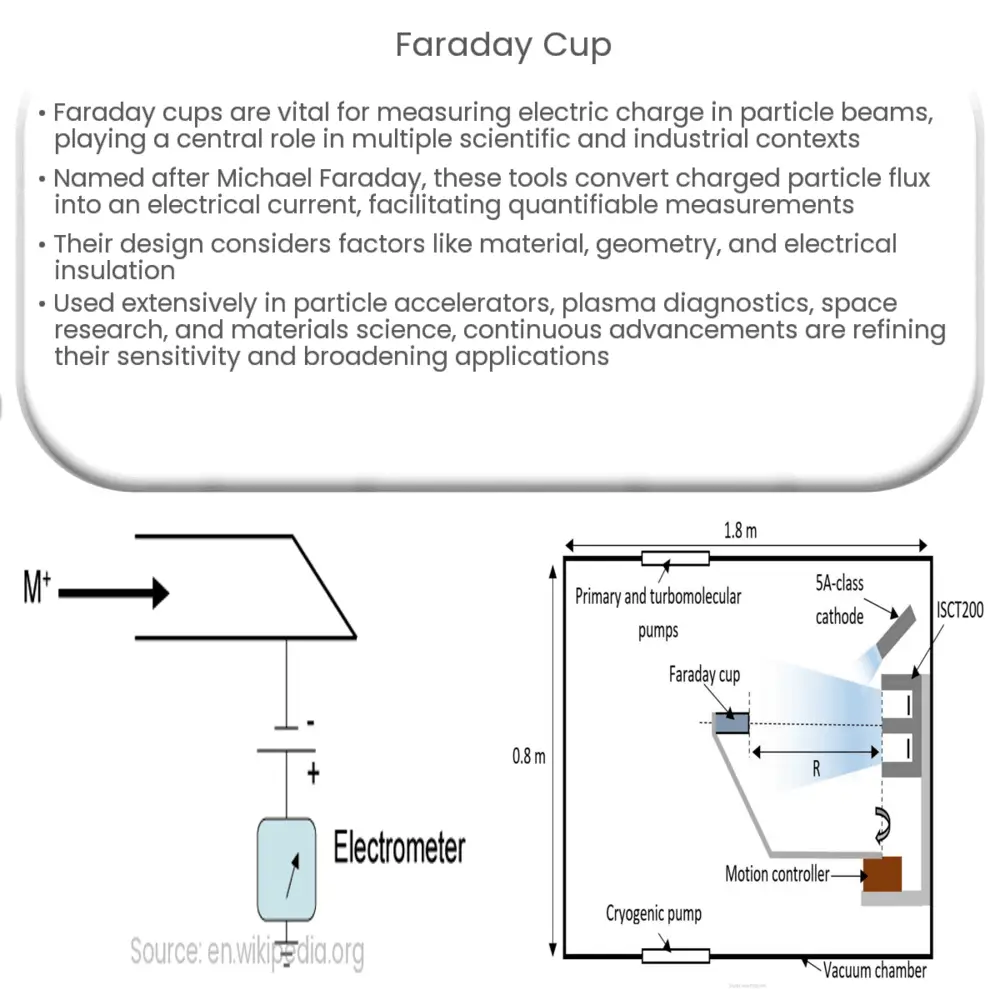Faraday cups measure electric charge in particle beams, essential in particle accelerators, plasma diagnostics, space research, and mass spectrometry.

Faraday Cup: A Crucial Tool for Measuring Electric Charge in Particle Beams
Faraday cups are essential tools for measuring electric charge in particle beams, and they play a vital role in numerous scientific and industrial applications. This article will delve into the fundamental principles behind Faraday cups, their design and construction, and the numerous applications that have made them indispensable in the modern world.
Understanding the Faraday Cup: Basic Principles and Operation
A Faraday cup, named after the renowned scientist Michael Faraday, is an instrument used to measure the electric charge of charged particles, such as electrons, ions, and even dust particles. The main principle behind a Faraday cup is the conversion of charged particle flux into an electrical current, which can be easily measured and quantified.
In its simplest form, a Faraday cup consists of a conductive cup or cylinder with an aperture, which is used to capture incoming charged particles. As charged particles enter the cup, they are collected on the inner surface of the conductive material, resulting in a buildup of electric charge. This accumulated charge is then discharged through a resistor, creating an electrical current proportional to the number of particles captured. By measuring the current and taking into account the sensitivity of the system, scientists can accurately quantify the electric charge of the particle beam.
Faraday Cup Design and Construction
While the basic concept of a Faraday cup is simple, its design and construction require careful consideration of several factors to ensure accurate measurements. Some of the key components and design considerations include:
- Material: Faraday cups are typically made of conductive materials such as copper, brass, or stainless steel. The choice of material depends on the type of charged particles to be measured and the desired level of sensitivity.
- Geometry: The shape and size of the Faraday cup play a crucial role in its performance. The geometry should be optimized to minimize secondary electron emission, which can interfere with the accuracy of the measurements. Cylindrical cups with a small entrance aperture and a larger inner volume are commonly used for this purpose.
- Electrical insulation: To prevent leakage currents and ensure accurate measurements, the Faraday cup must be electrically insulated from its surroundings. This is typically achieved using insulating materials such as ceramics or glass.
- Electrical connections: A Faraday cup must be connected to an appropriate measurement system to convert the captured charge into an electrical current. This typically involves the use of a high-precision resistor and a sensitive current measurement device, such as a picoammeter.
These design considerations help to ensure that Faraday cups provide accurate, reliable, and consistent measurements of electric charge in particle beams, making them a fundamental tool in numerous scientific and industrial applications.
Applications of Faraday Cups
Faraday cups have a wide range of applications in various scientific and industrial fields. Some of the most notable uses include:
- Particle accelerators: Faraday cups are commonly employed in particle accelerators to measure beam current and diagnose beam properties, ensuring the proper functioning and optimization of these complex machines.
- Plasma diagnostics: In plasma physics research, Faraday cups are used to measure ion and electron fluxes, providing valuable insights into plasma behavior and properties.
- Space research: Faraday cups have been used in numerous space missions to measure charged particle fluxes in Earth’s magnetosphere, the solar wind, and other cosmic phenomena.
- Materials science: Faraday cups can be utilized in materials research to investigate surface properties and the interactions between energetic particles and solid surfaces.
- Mass spectrometry: In mass spectrometry, Faraday cups serve as detectors for charged particles, helping researchers identify and quantify the composition of various samples.
Advancements and Future Developments
As research and technology continue to advance, improvements in Faraday cup design and performance are expected. Some of the current developments and future prospects include:
- Increased sensitivity: Ongoing research aims to improve the sensitivity of Faraday cups, allowing for the detection of even smaller currents and lower charged particle fluxes.
- Improved materials: The development of new conductive materials and insulating coatings may lead to enhanced performance and durability of Faraday cups, particularly in harsh environments such as space or high-temperature plasmas.
- Miniaturization: The trend towards miniaturization in electronics and instrumentation may result in smaller, more portable Faraday cups, opening up new application possibilities.
- Integration with other diagnostics: Combining Faraday cup technology with other diagnostic tools, such as spectrometers or imaging systems, may offer a more comprehensive understanding of charged particle interactions and properties.
In conclusion, Faraday cups are indispensable tools for measuring electric charge in particle beams and have a broad range of applications in various scientific and industrial fields. As technology and research progress, we can expect to see continued advancements in Faraday cup design and performance, further enhancing their capabilities and expanding their potential uses.

